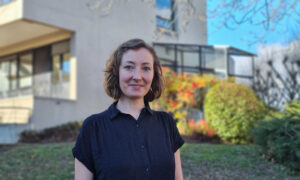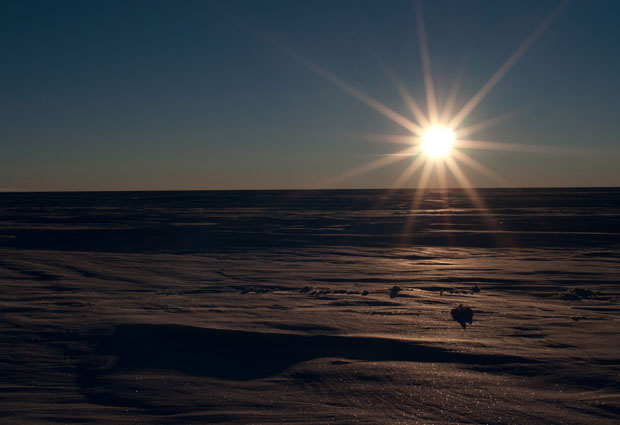
Read the latest Issue
Working on scientific instruments has taken EMBL alumnus Simon Sheldon to the ends of the Earth

It’s the weekend. You’re in a tent and there’s a storm blowing outside. A snowstorm. It’s been going on for nearly five days. There are snowdrifts taller than you are, although the visibility’s so low you can barely see them. You’re on Flade Isblink – an ice cap nine degrees from the North Pole. Help, if you need it, has to come from a military base 50 km away. The wind speed is 40 mph, the temperature is -12 °C, your tents are collapsing to left and right, and the last of your three generators has just packed up.
This is how things looked for EMBL alumnus Simon Sheldon on 21 May 2006, when he was one of a team of nine on an ice core drilling expedition to Greenland. When the weather turned harsh, their generators began breaking down as a result of various manufacturing faults and the intake of snow into the air inlets. Despite a series of repairs, by the fifth day of the storm they had no working generators. They ended up using two Primus stoves to heat the main tent while they salvaged parts from two generators to make one working one. “We had one tent that was just full of engine parts everywhere,” says Sheldon. “A few of us got covered in oil up to our elbows, and with such a limited supply of water there was no chance of washing it off.” Finally they managed to restore power, and within two days the weather calmed, becoming relatively mild for Greenland. He can smile about it now, but at the time it wasn’t clear how things would turn out. “It was never a life or death situation,” he explains, “but it was tough. We came pretty close to abandoning the project.”
When I first stood on the ice it was an incredible feeling. I couldn’t believe I’d finally got there
Sheldon has spent more than a year and a half of his life in the polar regions – a total of 550 days spread over fourteen years. Based at the Niels Bohr Institute in Copenhagen, he currently runs a laboratory in the field of quantum technology, but until May 2017 he worked as an engineer on ice core drilling projects in Greenland and Antarctica. This role took him to Greenland twelve times and Antarctica three times, for periods ranging from just over a week up to three months. His focus was primarily on developing drilling technology and the instrumentation for analysing ice core samples. He also built up expertise in field operations, dealing with things like the logistics of getting teams into the field, setting up camp, and using satellite and radio communications. “I enjoy planning operations, trying to recognise where problems can occur and reducing the chances of them happening,” he says. “But in the field, things always take you by surprise. There’s always something that breaks, something that’s been working for years and then suddenly gives up. There’s a lot of – shall we say – excitement from a technical point of view.”

Sheldon first became curious about travelling to Antarctica when he was a teenager. It was a combination of two things: one was watching films and reading stories about the Heroic Age of Antarctic Exploration, such as Shackleton’s failed attempt to cross Antarctica in 1914, and the daring rescue mission that followed. Another was a fascination with the idea of going to a place that had been visited by relatively few people, and getting to live in a real survival situation in a harsh environment. “I’d always enjoyed camping,” says Sheldon, “and this seemed like camping taken to the ultimate extreme.”
For a long time, it was just an idea. Not something he believed would ever be part of real life. After studying applied physics at university he began working for a company called Cambridge Instruments, developing technologies for electron microscopy and electron beam lithography. In 1993 he made the move to EMBL in Heidelberg, joining the group of Max Haider where he worked on techniques to improve electron microscopy images. He also met his future wife, EMBL alumna Susanne Lønstrup. After a few years they left to settle in Susanne’s home country of Denmark. Sheldon spent six months refurbishing an old farmhouse they’d bought there, before taking up a position in the Geophysics department at the Niels Bohr Institute. He joined an engineering team focused on improving ice core drilling equipment for the recovery of scientific-quality ice cores, and designing instrumentation for analysing ice core samples. He was 36 when he visited Antarctica for the first time. “When I first stood on the ice it was an incredible feeling,” he says. “I couldn’t believe I’d finally got there.”
In the 2013–14 austral summer, Sheldon was working in Antarctica as part of an Australian-led operation at Aurora Basin North. Returning from a break, he saw the principal investigator drop part of an ice core, shattering it. “If you consider the amount of time and effort you put in personally, and the costs involved in sending a team to Antarctica and running these drilling operations, the value of these ice cores is tens of thousands of euros per metre,” Sheldon explains. “So when I saw him drop this piece of ice, it was horrifying.” It turned out that his colleague had made a fake ice core by freezing water in a bag, so it was all an elaborate joke. “I was so devastated, he couldn’t keep up the pretence for more than a minute or so before he had to tell me,” says Sheldon. “But immediately I could see the funny side – it was a very good prank.”
Lighter moments like this provide a welcome balance to the hard work of being in the field, which often involves working twelve or more hours per day in very tough conditions. The work of people like Sheldon and his colleagues serves a serious purpose too. The ice cores they collect play a vital role in studies of ancient climate, allowing scientists to better understand the interactions between atmospheric composition and the Earth’s temperature, and to refine models of current climate change. Sheldon’s group has also collaborated with researchers such as Eske Willerslev, an evolutionary geneticist whose work has involved extracting ancient DNA from the bottom of ice cores, where they make contact with the underlying rock. Willerslev’s research has revealed a warmer past in southern Greenland several hundred thousand years ago, with various insect species crawling and buzzing amid forests of conifer trees.
Greenland and Antarctica are extraordinary places to work, but for Sheldon and his colleagues there’s rarely time to enjoy their surroundings. “We’re busy, there’s lots to do, and it’s expensive to be there, so the clock’s ticking and we don’t usually have time to pay attention to anything other than the job we’re there for,” he says. “But when we’ve finished a project we might have to wait several days or even weeks before a plane can come to pick us up. Then we do have a chance to look around.”
He describes otherworldly sights, such as sastrugi – grooves in the snow formed by wind erosion – and snow particles that the wind rolls along the surface, forming crystalline lumps that create striking light effects when the sun shines on them. At coastal stations in Antarctica he’s seen Weddell seals, emperor penguins and their chicks, and the special type of black moss that appears on the rocks during the summer. Then there is the grandeur of icebergs floating past – so large that they’re often visible several kilometres out to sea. “It might not happen often, but it’s good to have those opportunities every now and then,” he says. “To stand back and really appreciate where you are.”
 Curiosity is a profoundly human trait. We start asking questions almost as soon as we learn to speak and continuously redefine our understanding of the world by questioning it. This is the driving force behind science, technology, engineering and maths. As part of our curiosity editorial theme, we are exploring what EMBL is curious about.
Curiosity is a profoundly human trait. We start asking questions almost as soon as we learn to speak and continuously redefine our understanding of the world by questioning it. This is the driving force behind science, technology, engineering and maths. As part of our curiosity editorial theme, we are exploring what EMBL is curious about.
Read more articles about curiosity and where it can take you.
Looking for past print editions of EMBLetc.? Browse our archive, going back 20 years.
EMBLetc. archive